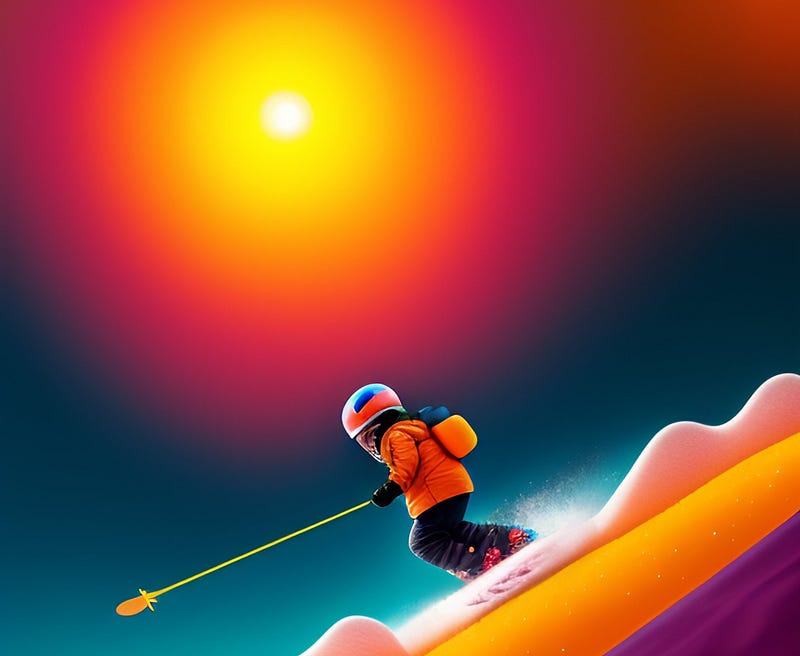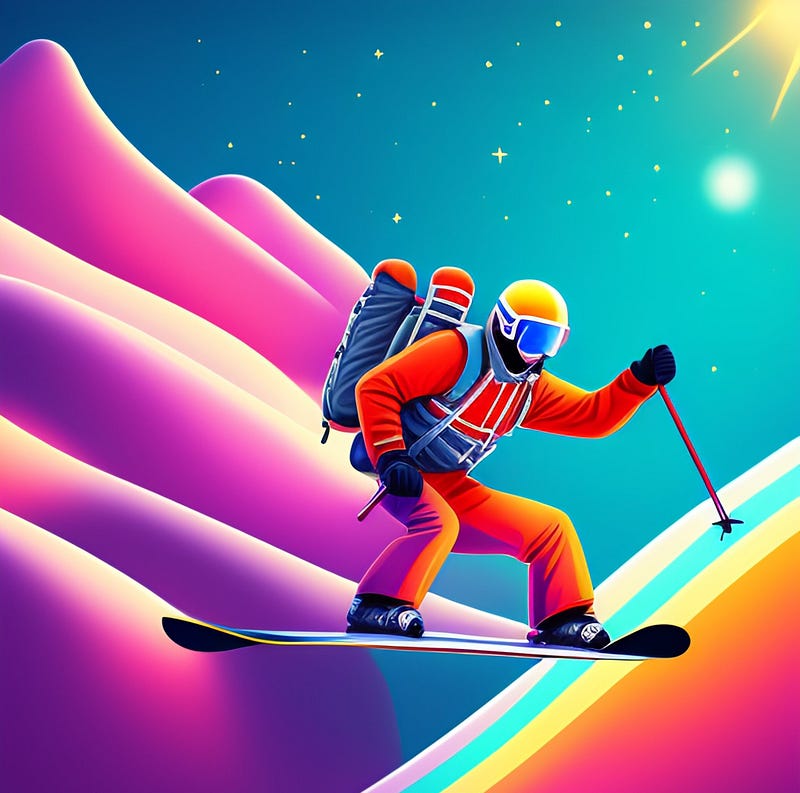The Skiing Industry's Struggle Against Climate Change
Written on
Chapter 1: The Alarming Decline of Winter Sports
Skiing and snowboarding are facing an existential threat due to the effects of climate change. In recent years, particularly during 2021 and 2022, many Swiss mountain resorts experienced remarkably low snowfall. As someone from Chicago with limited winter sports options, I had hoped to take my son snowboarding in Europe someday, but that dream now appears increasingly uncertain.

The warming climate is leading to a decrease in winter sports participation, especially with the diminishing snow and ice. As temperatures rise, ski resorts are struggling to maintain consistent snow coverage. This issue is particularly pronounced in lower-altitude areas, where reliance on artificial snow-making is growing. In Switzerland, the loss of snow has reached alarming levels in 2022 and 2023.
One major obstacle for ski resorts is the unpredictability of snowfall. Historically, resorts could rely on a certain amount of snow each season, but that consistency has been disrupted. This unpredictability complicates long-term planning and investment in essential infrastructure.
Furthermore, the ski season is becoming shorter. With rising temperatures, resorts are experiencing delayed openings and earlier closures, leading to decreased business and revenue as customers can no longer enjoy winter sports during traditional periods.
Climate change is also affecting the delicate ecosystems where these winter sports are situated. Ski resorts typically occupy regions with fragile environments that are now vulnerable to changing temperatures and precipitation patterns. The reduction in snow cover is detrimental to both wildlife and plant life, causing broader ecological repercussions.

Another consequence of climate change is the rising incidence of extreme weather events. Heavy rains, strong winds, and unusually warm temperatures can damage ski slopes, lift systems, and other infrastructure. Such conditions also pose safety risks for skiers and snowboarders, resulting in resort closures, lost revenue, and dissatisfied customers.
In response to these challenges, the ski industry is exploring various adaptation strategies. Some resorts are investing in snow-making technologies, which utilize water and compressed air to generate artificial snow. However, this method is energy-intensive and costly, raising questions about its sustainability in the face of increasingly erratic weather.
Additionally, ski resorts are diversifying their offerings to attract visitors year-round. Activities like hiking, biking, and other outdoor pursuits during the summer months are being promoted. Some resorts are also venturing into hosting conventions, weddings, and corporate events. However, smaller resorts that rely heavily on winter sports may struggle to make this shift.
The economic implications of climate change are dire for communities dependent on the ski industry. Ski resorts serve as crucial sources of income and employment for many mountain towns. As the ski season becomes shorter and less predictable, local economies may suffer from job losses, reduced income, and declining property values.
In summary, climate change poses a significant threat to the winter sports industry and the communities that rely on it. Ski resorts are grappling with challenges such as diminished snowfall, shortened seasons, and environmental impacts. While the industry is attempting to adapt, these measures may not suffice for long-term sustainability. It is imperative for individuals, ski resorts, and governments to work together to reduce carbon emissions and mitigate climate change effects, safeguarding the future of winter sports.

Chapter 2: The Consequences of Inaction
What could happen if we cannot reverse global warming? The ramifications would be extensive and severe. Climate change would exacerbate existing issues, resulting in more extreme weather, rising sea levels, and an increased frequency of heatwaves, droughts, and wildfires. These changes would wreak havoc on both human societies and natural ecosystems.
One major concern is food production. As temperatures rise, agricultural output may decline, leading to food insecurity in many areas. Furthermore, water scarcity will become a pressing issue, with droughts becoming more common and severe.
Human health would also suffer. Intensified heatwaves could lead to more heat-related illnesses and fatalities, while deteriorating air quality, resulting from increased wildfires and extreme weather, could heighten respiratory issues.
The natural environment would face severe challenges as well. Rising sea levels may inundate low-lying regions, destroying habitats for numerous species. Fluctuations in temperature and precipitation would disrupt ecosystems, causing biodiversity loss. Coral reefs, already threatened by ocean acidification, would endure further damage, with many species facing extinction.
Economically, the consequences of global warming would be substantial. The costs associated with damage from extreme weather and rising sea levels could be astronomical, affecting various industries. Tourism, agriculture, and fishing sectors could suffer, resulting in job losses and economic instability.
Additionally, the issue of security cannot be overlooked. Climate change could lead to food and water shortages, population displacement, and increased competition for resources, potentially inciting social unrest and conflict.
In conclusion, failing to reverse global warming could have catastrophic consequences for humanity and the natural world. Immediate and decisive action is essential to address this critical issue.
Chapter 3: Taking Action Against Climate Change
What can YOU do to help combat climate change? Here are a few suggestions:
- Reduce energy consumption: One of the main contributors to climate change is fossil fuel combustion. You can minimize greenhouse gas emissions by conserving energy—turn off lights when leaving a room, utilize energy-efficient appliances, and adjust your thermostat appropriately.
- Use public transportation, walk, or bike: Transportation significantly contributes to greenhouse gas emissions. Opting for public transit, walking, or biking can greatly reduce your carbon footprint.
- Eat less meat and dairy: Animal agriculture is a notable source of greenhouse gas emissions. Reducing your consumption of meat and dairy can help mitigate this impact.
- Plant trees: Trees absorb carbon dioxide, so planting one can help reduce atmospheric carbon levels.
- Support clean energy: Advocate for renewable energy sources like solar and wind power, invest in clean energy firms, and consider installing solar panels on your property.
- Educate yourself and others: Climate change is a complex issue. Staying informed and raising awareness can foster collective action.
- Vote with your wallet: Support environmentally responsible companies and boycott those that are not.
- Advocate for policies addressing climate change: Back politicians and legislation that prioritize climate action.
While these actions alone may not stop climate change, collective efforts can lead to significant impacts. The more individuals who take action, the greater the potential for change.
Chapter 4: The Future of Winter Sports
If snow disappears entirely, what lies ahead for winter sports? The outlook is bleak. Ski resorts, dependent on snow, may close or be forced to adapt drastically. Some may invest in snow-making technologies, but as weather patterns become increasingly unpredictable, this may not be a sustainable solution.
The ski industry, a vital source of income and employment for many mountain towns, would face severe consequences. A shorter, less predictable ski season would ripple through local economies, leading to job losses and reduced property values.
Athletes dedicated to winter sports may need to seek alternative ways to train, potentially transitioning to other sports or utilizing indoor facilities.
The cultural and lifestyle aspects associated with winter sports would also suffer. Many enthusiasts enjoy skiing and snowboarding not just for the sport but also for the connection to nature and the beauty of winter. The loss of these activities would be a significant blow to individuals and communities.
Winter sports encompass a wide variety of activities:
- Skiing: Popular in multiple forms, including alpine, cross-country, backcountry, and freestyle.
- Snowboarding: Similar to skiing, with styles like freeride, freestyle, and alpine.
- Sledding and Tobogganing: Enjoyed by people of all ages.
- Snowshoeing: Allows for exploration of winter landscapes.
- Cross-Country Skiing: Available for both recreational and competitive enthusiasts.
- Snowmobiling: Offers adventure in winter wilderness.
- Winter Triathlons and Marathons: Gaining popularity among winter sports lovers.
- Ice Skating, Curling, and Hockey: Still viable indoors.
The first video titled "Winter Sports: How Climate Change Is Affecting Ski Resorts" examines the challenges ski resorts face due to climate change, highlighting the drastic impact on winter sports.
The second video titled "Will Ski Resorts Survive Climate Change?" explores potential futures for ski resorts in light of ongoing climate challenges, raising critical questions about sustainability in the winter sports industry.